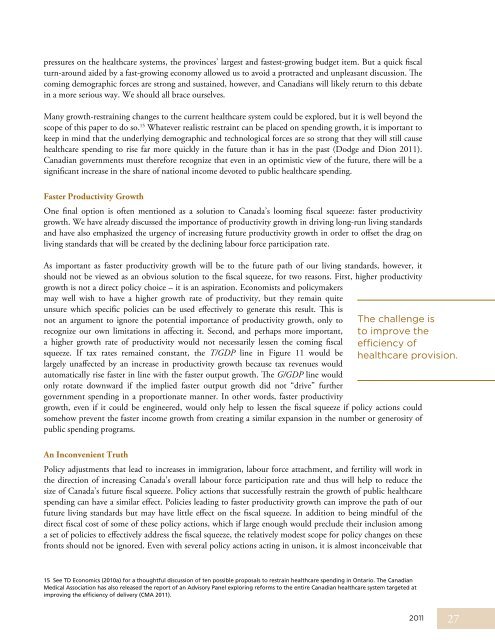Christopher Ragan, "Canada's Looming Fiscal Squeeze," November
Christopher Ragan, "Canada's Looming Fiscal Squeeze," November
Christopher Ragan, "Canada's Looming Fiscal Squeeze," November
Create successful ePaper yourself
Turn your PDF publications into a flip-book with our unique Google optimized e-Paper software.
pressures on the healthcare systems, the provinces’ largest and fastest-growing budget item. but a quick fiscal<br />
turn-around aided by a fast-growing economy allowed us to avoid a protracted and unpleasant discussion. The<br />
coming demographic forces are strong and sustained, however, and Canadians will likely return to this debate<br />
in a more serious way. We should all brace ourselves.<br />
many growth-restraining changes to the current healthcare system could be explored, but it is well beyond the<br />
scope of this paper to do so. 15 Whatever realistic restraint can be placed on spending growth, it is important to<br />
keep in mind that the underlying demographic and technological forces are so strong that they will still cause<br />
healthcare spending to rise far more quickly in the future than it has in the past (Dodge and Dion 2011).<br />
Canadian governments must therefore recognize that even in an optimistic view of the future, there will be a<br />
significant increase in the share of national income devoted to public healthcare spending.<br />
Faster Productivity Growth<br />
one final option is often mentioned as a solution to Canada’s looming fiscal squeeze: faster productivity<br />
growth. We have already discussed the importance of productivity growth in driving long-run living standards<br />
and have also emphasized the urgency of increasing future productivity growth in order to offset the drag on<br />
living standards that will be created by the declining labour force participation rate.<br />
As important as faster productivity growth will be to the future path of our living standards, however, it<br />
should not be viewed as an obvious solution to the fiscal squeeze, for two reasons. First, higher productivity<br />
growth is not a direct policy choice – it is an aspiration. economists and policymakers<br />
may well wish to have a higher growth rate of productivity, but they remain quite<br />
unsure which specific policies can be used effectively to generate this result. This is<br />
not an argument to ignore the potential importance of productivity growth, only to<br />
recognize our own limitations in affecting it. Second, and perhaps more important,<br />
a higher growth rate of productivity would not necessarily lessen the coming fiscal<br />
squeeze. If tax rates remained constant, the T/GDP line in Figure 11 would be<br />
largely unaffected by an increase in productivity growth because tax revenues would<br />
automatically rise faster in line with the faster output growth. The G/GDP line would<br />
only rotate downward if the implied faster output growth did not “drive” further<br />
government spending in a proportionate manner. In other words, faster productivity<br />
The challenge is<br />
to improve the<br />
efficiency of<br />
healthcare provision.<br />
growth, even if it could be engineered, would only help to lessen the fiscal squeeze if policy actions could<br />
somehow prevent the faster income growth from creating a similar expansion in the number or generosity of<br />
public spending programs.<br />
An Inconvenient Truth<br />
Policy adjustments that lead to increases in immigration, labour force attachment, and fertility will work in<br />
the direction of increasing Canada’s overall labour force participation rate and thus will help to reduce the<br />
size of Canada’s future fiscal squeeze. Policy actions that successfully restrain the growth of public healthcare<br />
spending can have a similar effect. Policies leading to faster productivity growth can improve the path of our<br />
future living standards but may have little effect on the fiscal squeeze. In addition to being mindful of the<br />
direct fiscal cost of some of these policy actions, which if large enough would preclude their inclusion among<br />
a set of policies to effectively address the fiscal squeeze, the relatively modest scope for policy changes on these<br />
fronts should not be ignored. even with several policy actions acting in unison, it is almost inconceivable that<br />
15 See TD Economics (2010a) for a thoughtful discussion of ten possible proposals to restrain healthcare spending in Ontario. The Canadian<br />
Medical Association has also released the report of an Advisory Panel exploring reforms to the entire Canadian healthcare system targeted at<br />
improving the efficiency of delivery (CMA 2011).<br />
2011<br />
27





